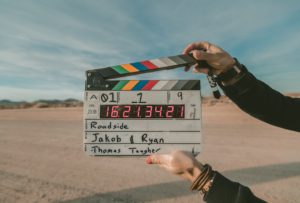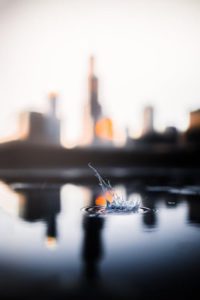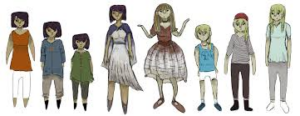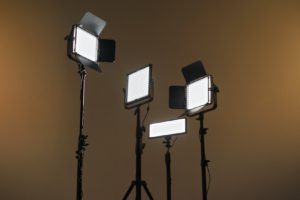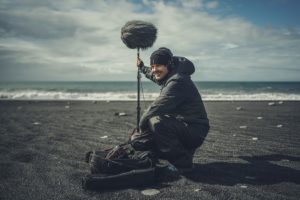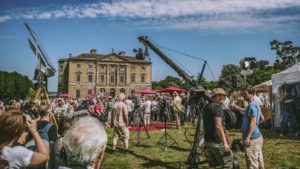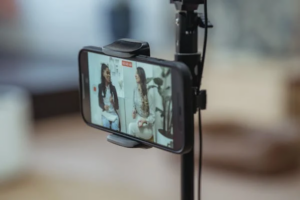You want a list of diverse camera angles in movies, as well as fantastic examples with clear explanations of when and why to employ each one. The importance of camera angles cannot be overstated, whether you want your characters to appear powerful, vulnerable, or intimate. Therefore, we will provide you with shot lists with all the camera shot angles used in movies.
Overview of Camera Shot Angles
It is not enough to know how big a shot is. The degree of camera angles can completely change the meaning of a photograph. It is easier to remember all the options when you’re making your shot list. We will use StudioBinder to create a shot list that highlights the various camera viewpoints. Here is a simple video on how to make a shot list.
Shot List Guide for Filmmakers
Shot List With Examples
The following is a short shot list with the various camera shot angles. As a sort of cheatsheet, we used some of the most memorable camera angles from films like The Matrix, Do the Right Thing, and Pulp Fiction.
Low Angle
The subject is framed from below their eye line in a low-angle manner. A low-angle shot of one character is frequently coupled with a high-angle picture of the other character to illustrate power dynamics between characters.
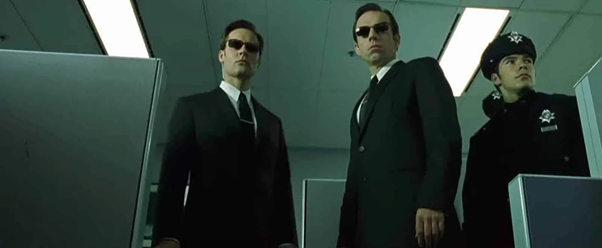
A Scene From Matrix
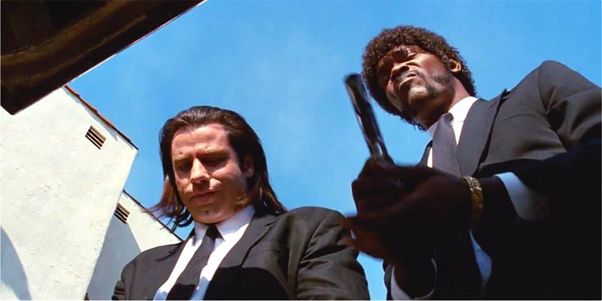
A Scene From Pulp Fiction
Low-angle camera angles are ideal for conveying supremacy or instilling feelings of terror and dread. Here’s a movie that goes over some of the many low-angle shot examples and how filmmakers like Wes Anderson, Orson Welles, and Spike Jonze have used them. You can learn more about low-angle shots here.
High Angle
The camera, in a high-angle shot, is pointing down at your subject. It frequently makes you feel inferior to your subject as if you are “looking down” on them. However, as with any other camera angle, there are several applications.
Here’s a video showing how to incorporate high-angle images into your film. However, as the movie below demonstrates, you may use the high-angle shot in traditional and more innovative ways.
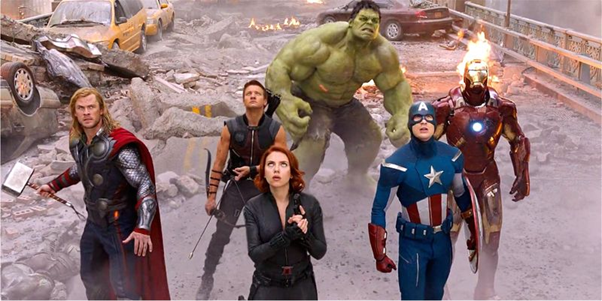
The Avengers
Dutch Angle
The camera is inclined to one side for a Dutch angle (Dutch tilt). You can generate a sensation of disorientation, a destabilized mental state, or heighten tension by tilting the horizon lines in this fashion.
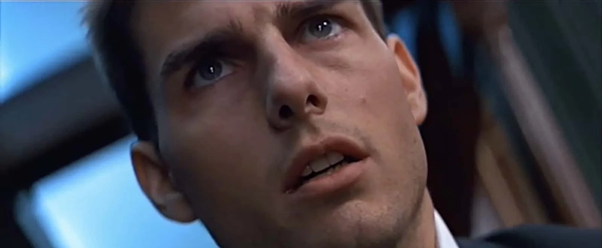
Mission Impossible
Here’s a video demonstrating a Dutch camera angle in action, focused on the exact timing of using one. Watch as the scene starts with “regular” and “level” shots before transitioning to Dutch angles for maximum effect.
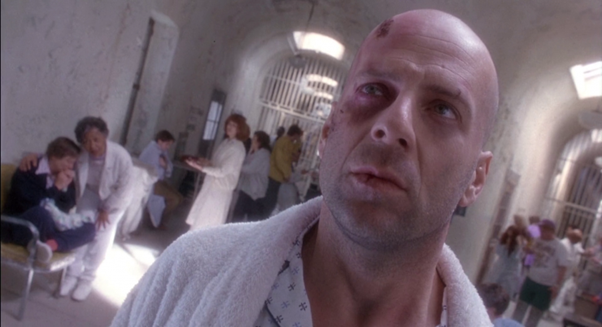
Twelve Monkeys
You can learn more about Dutch angle shots here.
Overhead Shot
An overhead shot is taken from above and looks down on your subject. These are usually filmed from 90 degrees above; anything less would be termed a low-angle shot.
An overhead shot doesn’t need to be extremely high, but it can be. Here’s an example of a camera angle used for an overhead shot
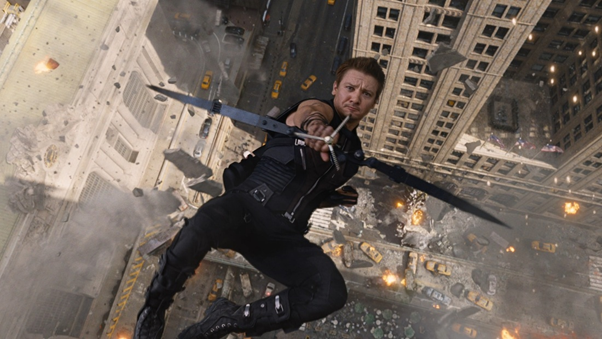
Avengers
Overhead views are excellent for giving a scene perspective — but not just any perspective. It is frequently employed as a “neutral” or even “divine” viewpoint.
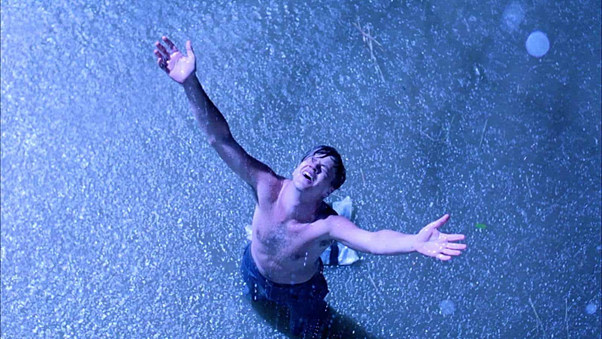
Shawshank Redemption
You can learn more about overhead-shot here.
Eye Level
You can achieve a neutral perspective by shooting at eye level (not superior or inferior). This is similar to how we view people in real life, with our eye lines intersecting with theirs, and it has the potential to tear down barriers.
Here’s an example of a camera angle at eye level:
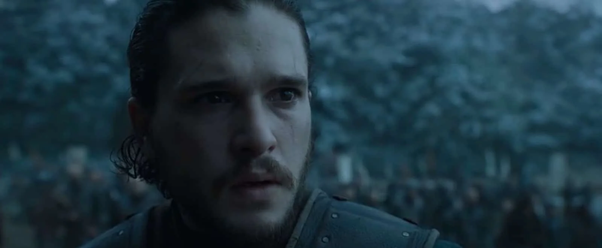
Game of Thrones
Directors often choose to set the camera at shoulder level to provide a much more cinematic effect. Therefore, eye-level shots are far less common than one might imagine.
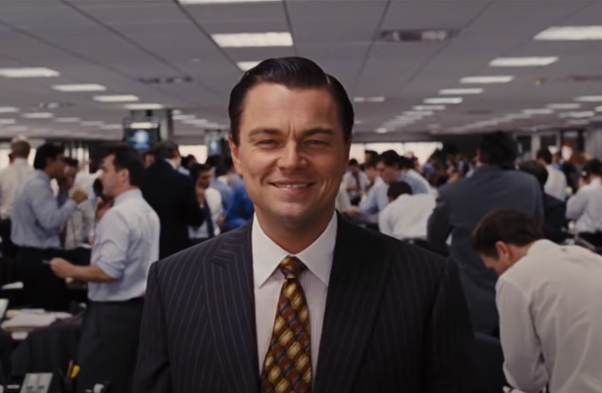
The Wolf of Wall Street
Shoulder Level
A camera angle that is as high as your subject’s shoulders is known as a shoulder-level shot. Shoulder-level shots are more common than eye-level shots, which can make your performer appear shorter than he or she is.
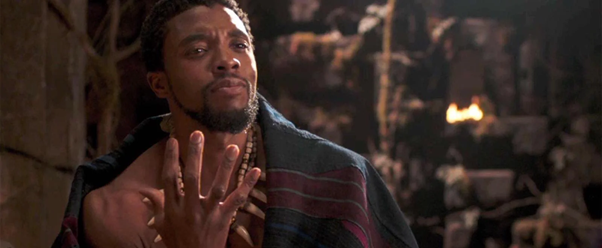
Black Panther
The actor’s head can reach the top of the frame because the camera is aligned with the shoulder. It also raises the actor’s eye line slightly above the camera, giving the impression of a lower viewpoint.
Over the Shoulder Shot/OTS Shot
Another angle that might change a viewer’s perception of a scene is an over-the-shoulder shot. For example, a close-up of another character’s face taken from “over the shoulder” of another character is used to show conflict or confrontation in an OTS shot.
When you don’t want to employ a POV, you can use an OTS wide shot to portray a character looking out over a landscape or going through an action sequence.
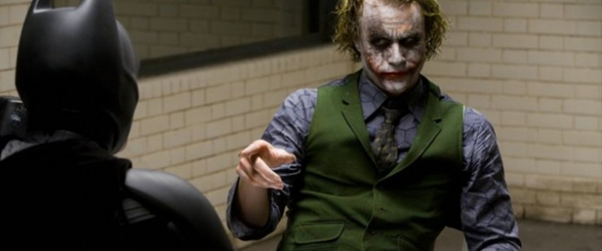
The Dark Knight
You can learn more about over-the-shoulder shots here.
Hip Level or Cowboy Shot
When your camera is around waist-high, you’re taking a cowboy shot. However, hip-level pictures are typically beneficial when one person is seated, and the other is standing.
When you have the action near the hip, such as guns being drawn or someone reaching into their pocket, hip-level shots can be incredibly effective camera angles. That is why it’s also known as a “cowboy shot,” as we cannot think about hip-level shots without seeing a gun, holster, and a distant enemy.
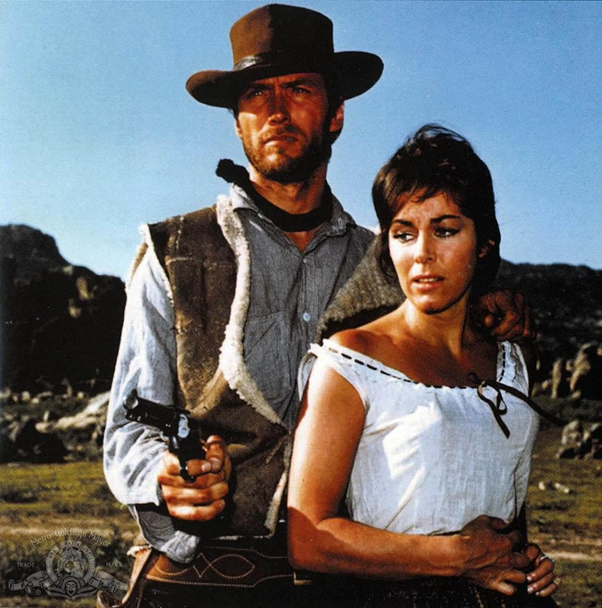
A Fistful Of Dollars (1964)
A hip-level shot will get the job done the further away you move from the subject, such as in this scene from Punch-Drunk Love, to maintain the subject framed with sufficient headroom.
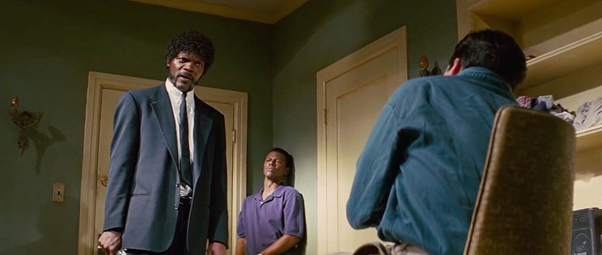
Pulp Fiction
You can learn more about cowboy or hip-level shot here.
Knee Level
When your camera is roughly as low as your subject’s knees, you’re in this position. When used with a low viewpoint, they might accentuate a character’s supremacy. It’s not as dramatic as a ground-level image, but it conveys the same emotion. These are great for focusing on characters strolling, or in this case, creeping, as in Home Alone.
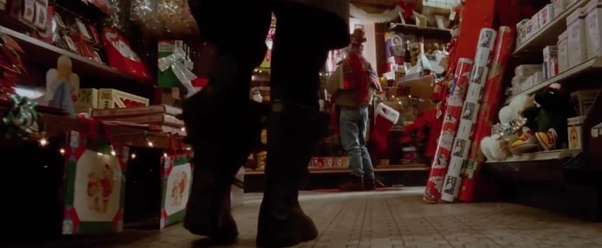
Home Alone
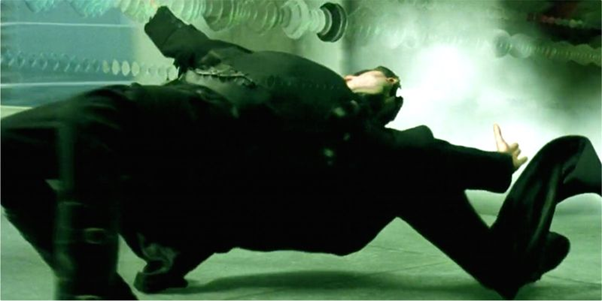
The Matrix
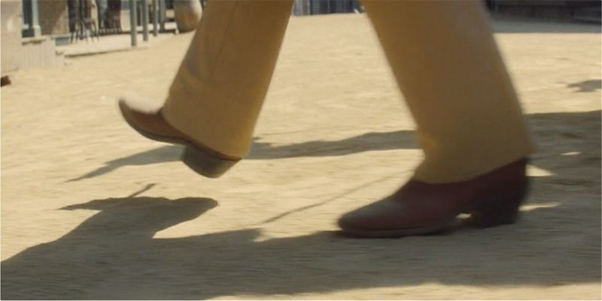
Scene From The Movie
Shot Size
The size of the frame in proportion to the subject is referred to as a shot size. Is your character in the picture, or is the character so far away that he/she is almost invisible? What more can you see in your photo? Is it possible to have many characters? Objects? Landscapes?
Let’s take a look at the five most common shot sizes and how they work:
Close-up (CU)
One of the most prevalent shot sizes in cinema is the close-up. It’s employed when you want to focus on your character’s facial features without any extraneous distractions in the image. For example, the character’s face is shown in a standard close-up from the brow to the chin.
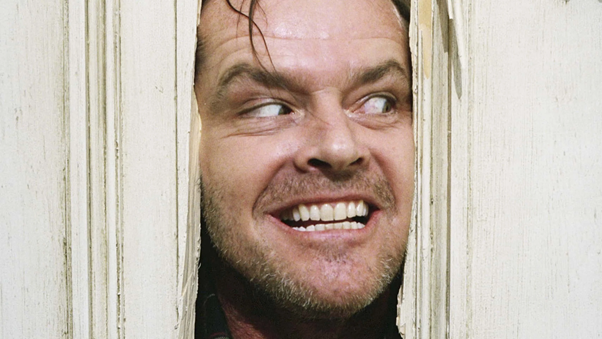
The Shining
There is, nevertheless, room for some creativity. An extreme close-up goes even further, frequently revealing only the character’s eyes. Consider a classic Western in which two characters face off before a duel. The viewer’s attention is drawn to facial features and expressions that would otherwise be lost in a wide shot.
Long Shot
In some senses, a long shot is the polar opposite of a close-up. It encompasses the complete body of the character, from head to toe. This provides a better feel of the subject’s surroundings and conveys information otherwise lost in a close-up.
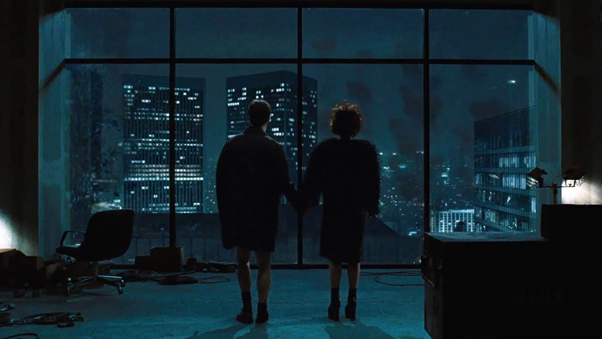
The Fight Club
When it’s crucial to show how the subject moves through his or her environment, long shots are frequently used in action scenes. You may cut from that extreme close-up of your two warring characters to a long shot that illustrates just how far apart they are, giving the audience a clearer perspective on the event.
One variation of this shot is an extreme long shot, in which the character is so far away they’re nearly lost in the frame or obscured by their surroundings. Think of a character riding off into the sunset, getting smaller as they get further away from the camera.
Medium Shot
A medium shot, also known as a mid-shot, falls in between a close-up and a long shot. The subject is shown from the top of their head to the bottom of their waist. It’s close enough to see their faces while also getting a glimpse of their body language.
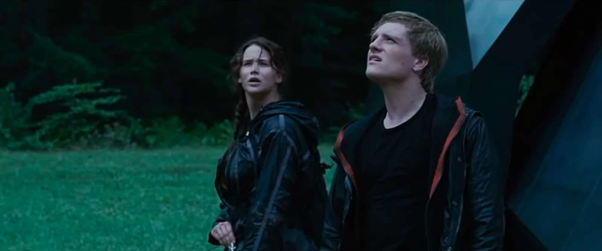
The Hunger Games
When a character is carrying an object or pointing at a gun, you can utilize this shot. You can even use this shot while writing a book sitting at a desk, avoiding wasting valuable screen space on the character’s feet or knees.
It is also handy when a character moves around the frame. It provides enough background information to keep the viewer from being disoriented.
Single, two-shot, three-shot
The quantity of individuals in the frame is another technique to classify a photograph. Depending on how many people are in it, we call it a single shot, a two-shot, or a three-shot.
This is usually combined with one of the other shot sizes we have discussed so far. A two-shot close-up, for example, could be used in a kissing scene between two people. A medium three-shot can be appropriate for three characters in an office.
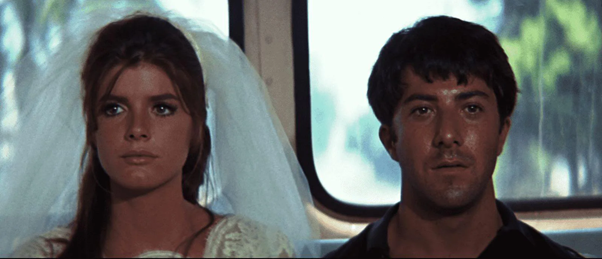
The Graduate
Point of View/POV Shot
Last but not least, there’s the POV (point-of-view) photo. This is utilized when you want the audience to see or experience what the character sees or feels.
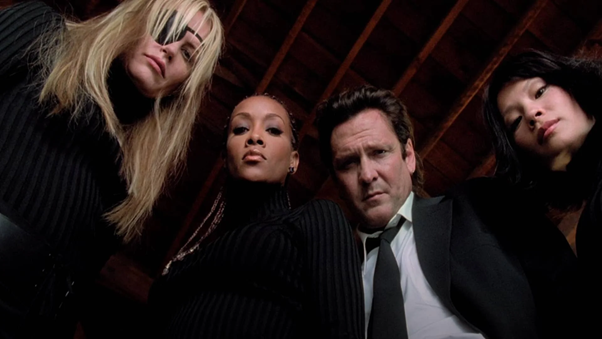
Django Unchained
Camera Movement
Camera motion or movement is the next category we’ll look at. You can use most of the shot sizes and angles we’ve examined as static or moving shots. However, you may switch between camera viewpoints by adding motion to a picture, sometimes even within the same shot. Let’s take a look at five popular camera movements:
Pan or Tilt
A pan or tilt is the most basic camera movement. A pan is when you keep the camera still and turn it to the side, while a tilt is when you move it up or down.
If your camera is on a tripod, you can simply turn the tripod head to one side to acquire a different viewpoint on a subject, just as you would turn your head to one side to gain a different perspective on a scene. For example, you can change an eye-level shot into a low-angle shot by tilting the camera up as the subject rises.
Experimenting with speed while panning or tilting is also a nice idea. You can show off a room or a landscape by panning slowly from left to right for an entire minute, or you can execute a whip pan, in which the movement is so quick that it blurs.


Tracking Shot, Dolly Shot, or Crane Shot
The key to a pan or tilt is that the camera does not move, giving the viewer the impression of being a spectator. You can use a tracking shot, dolly shot, or crane shot to proceed with a subject and make the audience feel like they’re a part of the action.
A tracking shot often moves horizontally, a dolly shot forwards or backward, and a crane shot up or down. Depending on your equipment, you can employ these movements separately or combine them to move on many axes at once.
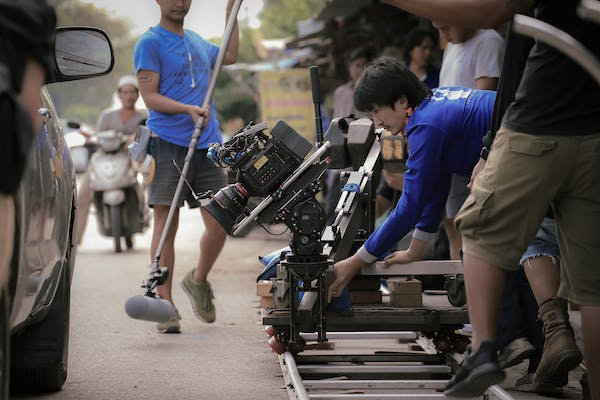
Zoom
Instead of moving the camera, a zoom shot uses a zoom lens to move into or out of the frame. Slowly zoom in on a subject’s face as they deliver an emotional monologue to make a medium shot into a close-up. You can even zoom out to see a previously unseen individual or object.
A zoom shot might be slow and subtle, so the viewer doesn’t notice it, or it can be more noticeable to give the scene a cinematic feel.
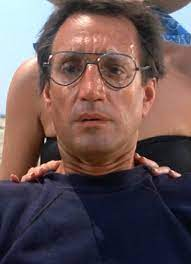
Jaws
Random Motion
Random motion is utilized to add energy and excitement to a scene, especially in action scenes. For example, consider The Bourne Identity. The camera moves so swiftly that the scene’s subject is not always framed in the frame.
While random motion might help create a sense of disorientation, it can also be overpowering, leaving viewers dizzy and bewildered.
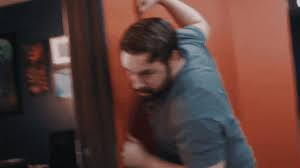
Scene From the Movie
360-Degree Motion
The final sort of motion we’ll look at is 360-degree motion, which involves the camera rotating entirely around the subject of the shot. These images are increasingly popular in the days of Steadicams and CGI. Still, they can be challenging to achieve on large film sets because they require hiding the personnel and equipment from view.
The Matrix used a unique camera setup for its 360-degree fight scenes, but you can also use a handheld camera or a drone.
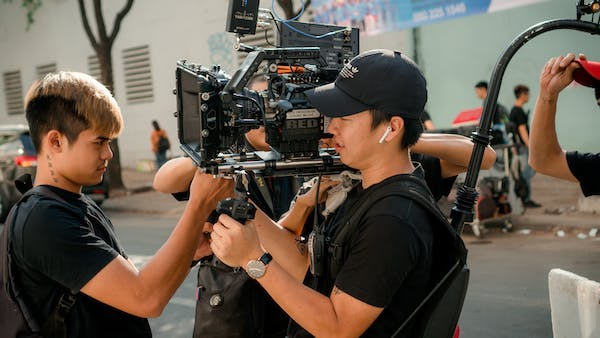
Compound Motion
The beauty of camera motion is that it does not have to be limited to just one axis at a time. Combining movements allows you to move in many dimensions simultaneously, resulting in more complicated images. Let’s look at two famous compound shots:
- Dolly Zoom: Dolly zoom is employed to elicit a feeling of dizziness or uneasiness. It was utilized in Alfred Hitchcock’s Vertigo and Steven Spielberg’s Jaws, among other films. In this shot, the camera moves forward or backward while the lens zooms in the opposite direction.
- Single Take: A single take is a long shot that incorporates several moves, shot sizes, and views. Instead of transitioning from a long shot to a close-up, the camera could track, zoom, pan, and tilt between several different shots. This is the most difficult to do properly, but it’s an efficient technique to orient viewers to a new place, as shown in Goodfellas’ opening image. It can also give a film a theatrical feel, such as in Birdman, shot in one long shot.
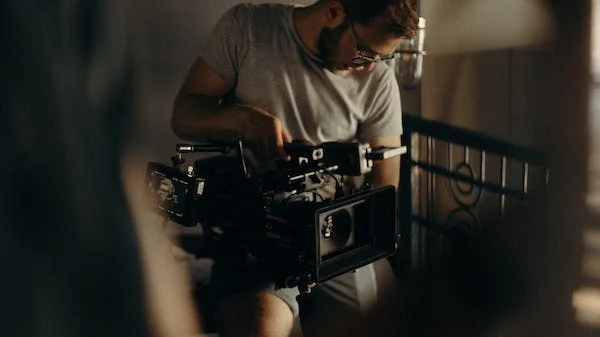
Conclusion
Camera Angles are not only a part of jargon to intellectualize the process of filmmaking. They are also used to communicate the nuances and subtleties of the situation. They offer a great deal of insight into a character’s thought process and help the viewer understand the intricacies in a scene.


